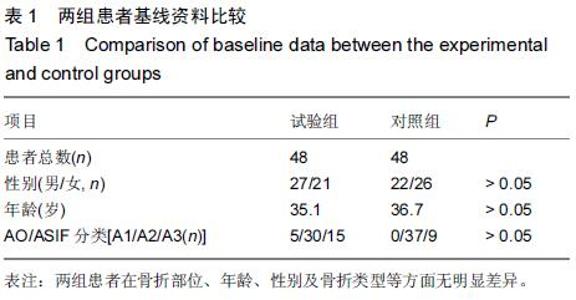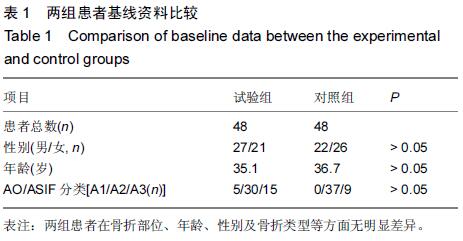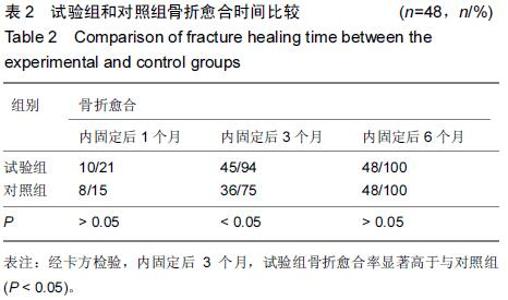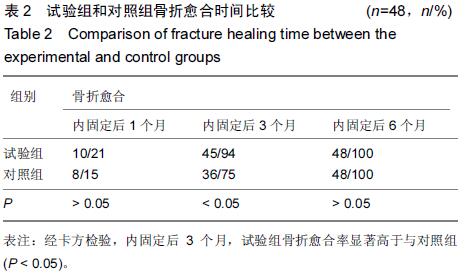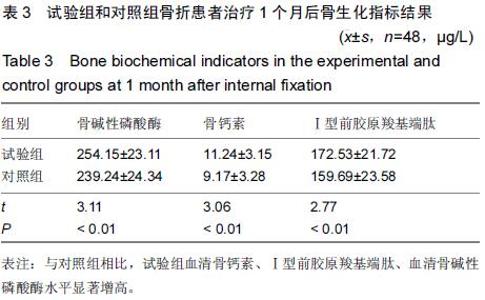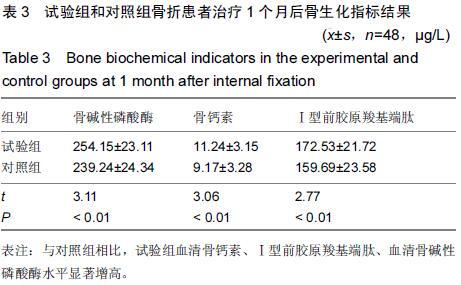Chinese Journal of Tissue Engineering Research ›› 2015, Vol. 19 ›› Issue (46): 7386-7390.doi: 10.3969/j.issn.2095-4344.2015.46.002
Previous Articles Next Articles
The potential role of original fracture hematoma in fracture healing
Lin Liang, Tang Ya-hui, Wu Lu-han, Xie Zeng-ru
- Department of Orthopedics, the First Affiliated Hospital of Xinjiang Medical University, Urumqi 830054, Xinjiang Uygur Autonomous Region, China
-
Received:2015-09-28Online:2015-11-12Published:2015-11-12 -
Contact:Xie Zeng-ru, Master, Chief physician, Professor, Master’s supervisor, Department of Orthopedics, the First Affiliated Hospital of Xinjiang Medical University, Urumqi 830054, Xinjiang Uygur Autonomous Region, China -
About author:Lin Liang, Studying for master’s degree, Department of Orthopedics, the First Affiliated Hospital of Xinjiang Medical University, Urumqi 830054, Xinjiang Uygur Autonomous Region, China -
Supported by:the Natural Science Foundation of Xinjiang Uygur Autonomous Region, No. 2014211C027
Cite this article
Lin Liang, Tang Ya-hui, Wu Lu-han, Xie Zeng-ru. The potential role of original fracture hematoma in fracture healing[J]. Chinese Journal of Tissue Engineering Research, 2015, 19(46): 7386-7390.
share this article
|
[1] Song YE, Tan H, Liu KJ,et al.Effect of fluoride exposure on bone metabolism indicators ALP, BALP, and BGP. Environ Health Prev Med. 2011;16(3):158-163.
[2] Zhou HY, Yan J, Fang L,et al.Change and significance ofIL-8, IL-4, and IL-10 in the pathogenesis of terminal Ileitis in SD rat. CellBiochem Biophys. 2014;69(2):327-331.
[3] Apalset EM, Gjesdal CG, Ueland PM,et al.Interferon gamma (IFN-γ)-mediated inflammation and the kynurenine pathway in relation to risk of hip fractures: the Hordaland Health Study. Osteoporos Int.2014;25(8):2067-2075.
[4] Volpin G, Cohen M, Assaf M,et al.Cytokine levels (IL-4, IL-6, IL-8 and TGFβ) as potential biomarkers of systemic inflammatory response intrauma patients. Int Orthop. 2014;38(6):1303-1309.
[5] Wang L, Park P, La Marca F,et al.BMP-2 inhibits tumor-initiatingability in human renal cancer stem cells and induces bone formation. J Cancer ResClin Oncol. 2015;141(6): 1013-1024.
[6] Muschter D,Göttl C,Vogel M,et al.Reactivity ofrat bone marrow macrophages to neurotransmitter stimulation in the context of collagen II-induced arthritis. Arthritis Res Ther. 2015;17:169.
[7] Echeverri LF, Herrero MA, Lopez JM,et al. Early stages of bone fracture healing: formation of a fibrin-collagen scaffold in the fracture hematoma. Bull Math Biol. 2015;77(1):156-183.
[8] Ozaki A, Tsunoda M, Kinoshita S,et al. Role of fracture hematoma and periosteum during fracture healing in rats: interaction of fracture hematoma and the periosteum in the initial step of the healing process. J Orthop Sci.2000;5(1):64-70.
[9] Song YE,Tan H,Liu Y, et al. Effect of fluoride exposure on bone metabolism indicators ALP, BALP, and BGP. 2011;16(3):158-163.
[10] 邢艳莉,汪春兰,赵宇.复合基因在骨缺损基因治疗中的研究进展[J].组织工程与重建外科杂志,2009.5(5):291-294.
[11] Stenfelt S, Hulsart-Billström G, Gedda L,et al. Pre-incubation of chemically crosslinked hyaluronan-based hydrogels,loaded with BMP-2 and hydroxyapatite, and its effect on ectopic bone formation.J Mater Sci Mater Med. 2014;25(4):1013-1023.
[12] Chouhan S, Sharma S. Down-Regulation of Acid and Alkaline Phosphatases Induced After Prolonged Diclofenac Use in Experimental Mouse Bone. Proceedings of the National Academy of Sciences, India Section B: Biological Sciences. 2014;1:37.
[13] Busti AJ,Hooper JS,Amaya CJ,et al. Effects of perioperative antiinflammatory and immunomodulating therapy on surgical wound healing.Pharmacotherapy. 2005;25(11):1566-1591.
[14] Göbel K, Bittner S, Melzer N,et al. CD4(+) CD25(+) FoxP3(+) regulatory T cells suppress cytotoxicity of CD8(+) effector T cells: implications for their capacity to limit inflammatory central nervous system damage at the parenchymal level. J Neuroinflammation. 2012;9:41.
[15] Cahill EF, Tobin LM, Carty F,et al. Jagged-1 is required for the expansion of CD4(+) CD25(+) FoxP3(+) regulatory T cells and tolerogenic dendritic cells by murine mesenchymal stromal cells. Stem Cell Res Ther. 2015;6:19.
[16] Chidrawar SM,khan N,Chan YL,et al. Ageing is associated with a decline in peripheral blood CD56bright NK cells. Immun Ageing. 2006;3:10.
[17] Ishikawa M, Nishioka M, Hanaki N ,et al. Postoperative host responses in elderly patients after gastrointestinal surgery. Hepatogastroenterology. 2006;53(71):730-735.
[18] Clowes JA, Riggs BL,Khosla S,et al. The role of the immune system in the pathophysiology of osteoporosis. Immunol Rev. 2005;208:207-227.
[19] Riggs BL, Khosla S ,Melton LJ,et al. Sex steroids and the construction and conservation of the adult skeleton. Endocr Rev. 2002;23(3):279-302.
[20] Opelz G, Döhler B. Association of mismatches for HLA-DR with incidence of posttransplant hip fracture in kidney transplant recipients. Transplantation.2011;91(1):65-69.
[21] Plackett TP,Wittle PL,Faunce DE,et al. Aging enhances lymphocyte cytokine defects after injury. FASEB J. 2003;17(6): 688-689.
[22] Gothard D, Smith EL, Kanczler JM,et al. Tissue engineered bone using select growth factors: A comprehensive review of animal studies and clinical translation studies in man. Eur Cell Mater. 2014;28:166-207.
[23] Kempen DH,Lu l,Heijink A,et al. Effect of local sequential VEGF and BMP-2 delivery on ectopic and orthotopic bone regeneration. Biomaterials. 2009;30(14):2816-2825.
[24] Dimitriou R, Carr IM, West RM,et al. Genetic predisposition to fracture non-union: a case control study of a preliminary single nucleotide polymorphisms analysis of the BMP pathway. BMC Musculoskelet Disord. 2011;12:44.
[25] Zhang Y,Cheng N,Shi B,et al. Delivery of PDGF-B and BMP-7 by mesoporous bioglass/silk fibrin scaffolds for the repair of osteoporotic defects.Biomaterials. 2012;33(28):6698-6708.
[26] Hao X, Silva EA, Brodin LA,et al .effects of sequential release of VEGF-A165 and PDGF-BB with alginate hydrogels after myocardial infarction. Cardiovasc Res. 2007;75(1):178-185.
[27] Nillesen ST,Wismans R,Daamen R,et al.Increased angiogenesis and blood vessel maturation in acellular collagen-heparin scaffolds containing both FGF2 and VEGF. Biomaterials. 2007;28(6):1123-1131.
[28] Kaipel M, Schützenberger S, Schultz A,et al. BMP-2 but not VEGF or PDGF in fibrin matrix supports bone healing in a delayed-union rat model. J Orthop Res. 2012;30(10):1563-1569. |
| [1] | Zhang Tongtong, Wang Zhonghua, Wen Jie, Song Yuxin, Liu Lin. Application of three-dimensional printing model in surgical resection and reconstruction of cervical tumor [J]. Chinese Journal of Tissue Engineering Research, 2021, 25(9): 1335-1339. |
| [2] | Zeng Yanhua, Hao Yanlei. In vitro culture and purification of Schwann cells: a systematic review [J]. Chinese Journal of Tissue Engineering Research, 2021, 25(7): 1135-1141. |
| [3] | Yang Weiqiang, Ding Tong, Yang Weike, Jiang Zhengang. Combined variable stress plate internal fixation affects changes of bone histiocyte function and bone mineral density at the fractured end of goat femur [J]. Chinese Journal of Tissue Engineering Research, 2021, 25(6): 890-894. |
| [4] | Xu Dongzi, Zhang Ting, Ouyang Zhaolian. The global competitive situation of cardiac tissue engineering based on patent analysis [J]. Chinese Journal of Tissue Engineering Research, 2021, 25(5): 807-812. |
| [5] | Wu Zijian, Hu Zhaoduan, Xie Youqiong, Wang Feng, Li Jia, Li Bocun, Cai Guowei, Peng Rui. Three-dimensional printing technology and bone tissue engineering research: literature metrology and visual analysis of research hotspots [J]. Chinese Journal of Tissue Engineering Research, 2021, 25(4): 564-569. |
| [6] | Chang Wenliao, Zhao Jie, Sun Xiaoliang, Wang Kun, Wu Guofeng, Zhou Jian, Li Shuxiang, Sun Han. Material selection, theoretical design and biomimetic function of artificial periosteum [J]. Chinese Journal of Tissue Engineering Research, 2021, 25(4): 600-606. |
| [7] | Liu Fei, Cui Yutao, Liu He. Advantages and problems of local antibiotic delivery system in the treatment of osteomyelitis [J]. Chinese Journal of Tissue Engineering Research, 2021, 25(4): 614-620. |
| [8] | Li Xiaozhuang, Duan Hao, Wang Weizhou, Tang Zhihong, Wang Yanghao, He Fei. Application of bone tissue engineering materials in the treatment of bone defect diseases in vivo [J]. Chinese Journal of Tissue Engineering Research, 2021, 25(4): 626-631. |
| [9] | Zhang Zhenkun, Li Zhe, Li Ya, Wang Yingying, Wang Yaping, Zhou Xinkui, Ma Shanshan, Guan Fangxia. Application of alginate based hydrogels/dressings in wound healing: sustained, dynamic and sequential release [J]. Chinese Journal of Tissue Engineering Research, 2021, 25(4): 638-643. |
| [10] | Chen Jiana, Qiu Yanling, Nie Minhai, Liu Xuqian. Tissue engineering scaffolds in repairing oral and maxillofacial soft tissue defects [J]. Chinese Journal of Tissue Engineering Research, 2021, 25(4): 644-650. |
| [11] | Cheng Shigao, , Wang Wanchun, Jiang Dong, Li Tengfei, Li Xun, Ren Lian. Comparison of the standard and long-stem bone cement prosthesis replacement in the treatment of intertrochanteric fractures in elderly patients [J]. Chinese Journal of Tissue Engineering Research, 2021, 25(3): 362-367. |
| [12] | Xing Hao, Zhang Yonghong, Wang Dong. Advantages and disadvantages of repairing large-segment bone defect [J]. Chinese Journal of Tissue Engineering Research, 2021, 25(3): 426-430. |
| [13] | Chen Siqi, Xian Debin, Xu Rongsheng, Qin Zhongjie, Zhang Lei, Xia Delin. Effects of bone marrow mesenchymal stem cells and human umbilical vein endothelial cells combined with hydroxyapatite-tricalcium phosphate scaffolds on early angiogenesis in skull defect repair in rats [J]. Chinese Journal of Tissue Engineering Research, 2021, 25(22): 3458-3465. |
| [14] | Wang Hao, Chen Mingxue, Li Junkang, Luo Xujiang, Peng Liqing, Li Huo, Huang Bo, Tian Guangzhao, Liu Shuyun, Sui Xiang, Huang Jingxiang, Guo Quanyi, Lu Xiaobo. Decellularized porcine skin matrix for tissue-engineered meniscus scaffold [J]. Chinese Journal of Tissue Engineering Research, 2021, 25(22): 3473-3478. |
| [15] | Mo Jianling, He Shaoru, Feng Bowen, Jian Minqiao, Zhang Xiaohui, Liu Caisheng, Liang Yijing, Liu Yumei, Chen Liang, Zhou Haiyu, Liu Yanhui. Forming prevascularized cell sheets and the expression of angiogenesis-related factors [J]. Chinese Journal of Tissue Engineering Research, 2021, 25(22): 3479-3486. |
| Viewed | ||||||
|
Full text |
|
|||||
|
Abstract |
|
|||||
